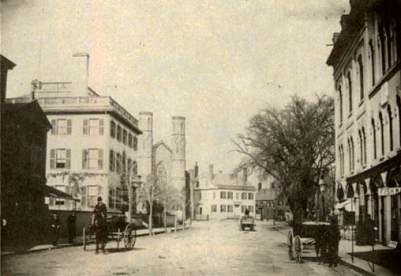Washington Square Historic District

West side of Washington Square from Essex Street
Photograph courtesy of the Peabody Essex Museum
West side from Essex Street. This district was established in 1977 and includes the nine-acre Salem Common, properly called Washington Square, and most of the structures which abut it on three surrounding streets, Washington Square North, South, and West. Several buildings on upper Winter Street are also included.
The Common has played an important role in the city's military and civic history since it was formally set aside as a training field for the local populace in 1714. It was not until 1802 when this open land was leveled and, a short time later, much improved by the erection of gates and a fence, that the abutting land became desirable for residential use. For two decades thereafter, a number of the city's leading merchants built imposing neo-classical mansions facing the Common. Foremost among these is the Andrew-Safford House (1818) at 13 Washington Square West. A number of houses in various revival styles were later built on remaining lots, resulting in an impressive concentration of early to mid-19th century dwellings.
The district also includes the city's principal hostelry, the Hawthorne Inn (1925), the entire Essex Institute complex, the statue of Salem's founder Roger Conant by H.H. Kitson (1913), and the Civil War Memorial at the head of Winter Street. One of the town's early schools , the Phillips School (1883), is also included.
